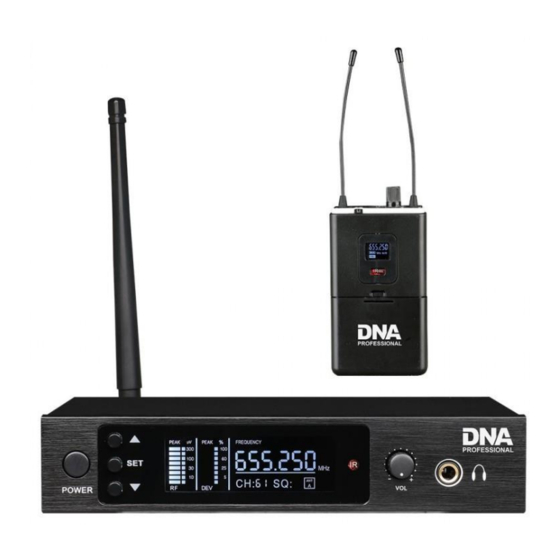
Advertisement
Available languages
Available languages
Quick Links
Advertisement

Summary of Contents for DNA Professional IN-EAR
- Page 1 IN-EAR USER MANUAL INSTRUKCJA OBSŁUGI...
-
Page 2: Transmitter Function
ENGLISH UHF DSP Wireless Microphone System Specification Modulation Method: ∏/4 – DQPSK Frequency Range: 518-542MHz, 2x100/4x50CH Sampling Ratio: 48KHz Transmission Rate: 204.8Kbps Dynamic Range >90dB Total Harmonic Distortion: <0.1% Delay Time of Audio Transmission: <3ms S/N Ratio: >96dB Frequency Response: 30~20KHz RX Sensitivity: <-94dBm Unique ID Address: Yes Some tips to improve the performance of the system... - Page 3 2) Rear Panel function 2. Bodypack Receiver Function...
- Page 4 Replacing the battery 3. How to select Frequencies/Channels for the receiver 1) Frequency/Channel select STEP 1: Press and hold „UP ” on the transmitter until the channel blinks. STEP 2: While the channel is blinking, press “UP or DOWN ” to select the desired channel.
- Page 5 4. How to match Transmitter’s frequency with Bodypack Receiver STEP1: Turn ON the receiver, point it to infrared port (IR) directly at transmitter’s IR PORT. NOTE> Please make sure that the other devices are powered off when adjusting the frequency on the receiver.
-
Page 6: Troubleshooting
6. Troubleshooting Trouble Status Solutions Turn on the transmitter power. Confirm that the +/- marks on The transmitter’s display is the battery match with the head joint of the transmitter. set off Insert new battery. Confirm whether a head of the AC power adapter is plugged into the power outlet, and whether the other end is inserted Receiver’s display is set off into the DC power supply socket on the rear panel of the... - Page 7 POLSKI Specyfikacja techniczna Modulacja: ∏/4 – DQPSK Zakres częstotliwości: 518-542MHz, 2x100/4x50CH Współczynnik próbkowania: 48KHz Prędkość przesyłu danych: 204.8Kbps Zakres dynamiki: >90dB Całkowite zniekształcenia harmoniczne: <0.1% Opóźnienie transmisji audio: <3ms Stosunek dźwięku do szumów: >96dB Pasmo przenoszenia: 30~20KHz Czułość RX: <-94dBm Wskazówki pomagające w uzyskaniu najlepszego efektu •...
- Page 8 2) Panel tylni 1 Gniazdo zasilania 5 Głośność wejścia L 2 Gniazdo anteny 6 Wejście Audio R 3 Wejście Audio L+R 7 Głośność wejścia R 4 Wejście Audio L 8 Wyjście Audio L+R 2. Elementy odbiornika bodypack 1) Antena 2) Zasilanie i głośność 3) Gniazdo słuchawek 4) Wskaźnik zasilania...
- Page 9 3. Wymiana baterii 4. Jak wybrać częstotliwość/kanał na nadajniku Wybór kanału/częstotliwości KROK 1: Wciśnij i przytrzymaj „UP ” na nadajniku aż wyświetlacz zacznie migotać. KROK 2: Następnie wciśnij “UP lub DOWN ” aby wybrać pożądany kanał. Wciśnij „SET” aby potwierdzić wybór.
- Page 10 5. Jak sparować częstotliwość odbiornika Bodypack z nadajnikiem KROK 1: Włącz odbiornik, skieruj jego port podczerwieni w kierunku portu podczerwieni nadajnika. UWAGA> Upewnij się, że drugi mikrofon jest wyłączony podczas parowania. Każdy mikrofon jest sprawdzany pod kątem sprawności po wyprodukowaniu. Jednakże w związku z nieprzewidywalnością...
-
Page 11: Rozwiązywanie Problemów
7. Rozwiązywanie problemów Problem Status Rozwiązanie Wyświetlacz nadajnika jest Włącz nadajnik. Upewnij się, że znaczniki baterii +/- pasują wyłączony do gniazda baterii. Wymień baterię na nową. Wyświetlacz odbiornika jest Upewnij się, że zasilacz jest podłączony do prądu oraz do wyłączony gniazda z tyłu odbiornika.

Need help?
Do you have a question about the IN-EAR and is the answer not in the manual?
Questions and answers